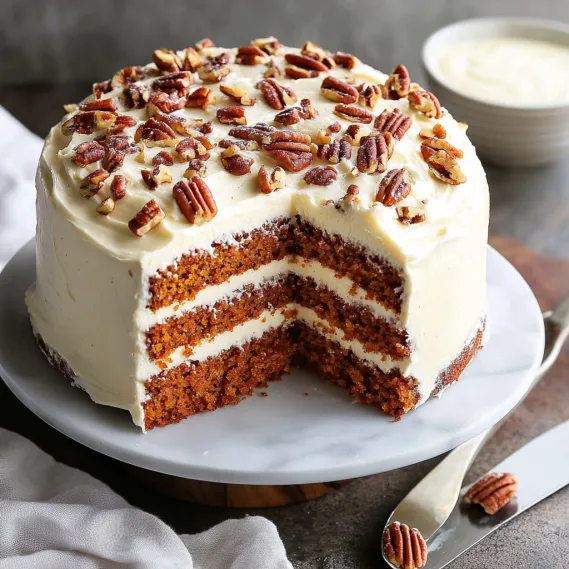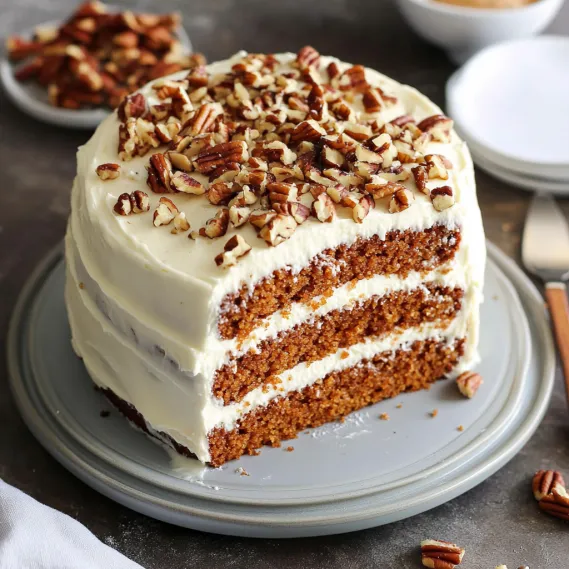 Pin
Pin
This isn't just carrot cake – it's a celebration on a plate. With its incredibly moist texture, perfect balance of spices, and velvety cream cheese frosting, this cake transforms humble carrots into something truly extraordinary. Every forkful delivers rich brown sugar sweetness, warm cinnamon and ginger notes, and the surprising crunch of toasted pecans. The tangy cream cheese frosting provides the perfect complement to the dense, tender cake layers. This isn't just dessert; it's the kind of cake that creates traditions and becomes the automatic answer to "What should we have for special occasions?"
I've been making this cake as my personal birthday tradition for years. What began as a once-yearly treat has expanded to become our family's go-to for Easter, spring brunches, baby showers, and community bake sales. The requests have become so predictable that I've stopped asking what dessert everyone wants – this carrot cake is always the unanimous answer. One year, I attempted to break tradition with a different birthday cake, only to have my family stage what can only be described as a loving intervention to bring back their beloved carrot cake.
Essential Ingredients and Selection Tips
- Brown Sugar: Use dark brown sugar for the deepest flavor and moisture. It's not just a sweetener; it's a major flavor component.
- Oil: Choose a neutral oil like vegetable or canola. Unlike butter-based cakes, oil keeps this cake exceptionally moist even when refrigerated.
- Freshly Grated Carrots: The non-negotiable star ingredient. Grate them yourself from whole carrots; pre-shredded carrots are too dry and will significantly impact the cake's moisture.
- Toasted Pecans: Taking the extra few minutes to toast them amplifies their nutty flavor throughout the cake.
- Cream Cheese: Use full-fat brick-style cream cheese, not the spreadable kind in tubs, for the proper frosting consistency.
I've learned through countless iterations that freshly grated carrots make all the difference in this recipe. The first time I used pre-shredded carrots from the grocery store, the cake was noticeably drier. When you grate carrots yourself, you'll be amazed at how much moisture they contain – that's essential wetness that gets baked right into your cake.
Detailed Cooking Instructions
- Step 1: Prepare Your Foundation
- Preheat your oven to 350°F and toast 1 cup pecans for 8 minutes until fragrant. While they cool, line three 9-inch cake pans with parchment paper circles and grease both the paper and pans. In a large bowl, whisk 2 cups flour, 2 teaspoons baking powder, 1 teaspoon baking soda, 1/2 teaspoon salt, 1 1/2 teaspoons cinnamon, 1 teaspoon ginger, and 1/4 teaspoon nutmeg.
- Step 2: Create The Perfect Batter
- In a separate bowl, whisk 4 large eggs, 1 1/2 cups brown sugar, 1 cup vegetable oil, 1/4 cup applesauce, and 2 teaspoons vanilla until smooth. Pour these wet ingredients into the dry ingredients and mix just until combined. Fold in 2 cups freshly grated carrots (about 4 large carrots) and the toasted chopped pecans, being careful not to overmix.
- Step 3: Master The Baking Technique
- Divide the batter evenly between your prepared pans and bake for 20-25 minutes, until a toothpick inserted in the center comes out clean with just a few moist crumbs. Let the cakes cool in the pans for 10 minutes before inverting onto wire racks to cool completely. Cooling is crucial before frosting – even slightly warm cakes will cause the frosting to melt.
- Step 4: Create Luscious Frosting
- Beat 16 ounces full-fat cream cheese and 1/2 cup unsalted butter (both at room temperature) until completely smooth. Add 4 cups powdered sugar, 1 1/2 teaspoons vanilla extract, and a pinch of salt. Beat on low initially, then increase to high until the frosting is creamy and smooth. For firmer frosting that's easier to pipe, refrigerate for 20 minutes.
- Step 5: Assemble Your Masterpiece
- Place one cake layer on your serving plate and spread with frosting. Top with the second layer, more frosting, then the final layer. Apply a thin crumb coat to the entire cake, chill for 15 minutes, then finish with the remaining frosting. For a simple but elegant decoration, press chopped pecans around the sides of the cake or create swirls on top with an offset spatula.

The first time I made this cake, I was shocked at how much moisture fresh carrots contain. After grating them, I was tempted to press out the excess liquid, thinking it might make the cake too wet. Thankfully, I followed the recipe as written, and that carrot moisture transformed into the most incredible texture I'd ever tasted in a cake. Now I know that those wet, freshly grated carrots are the secret to carrot cake perfection.
The Secret To Perfect Wok Technique
High heat is essential for authentic fried rice. My grandmother taught me to heat the wok until smoking before adding oil. Keep ingredients moving constantly to achieve that elusive "wok hei" flavor. Never overcrowd the pan—cook in batches instead. This technique transformed my fried rice into restaurant-quality perfection.

Making The Most Of Leftovers
This dish excels at transforming leftovers into something exciting. I've used roast chicken, holiday ham, and even Thanksgiving turkey with great success. Cut meat into uniform pieces that distribute evenly throughout. Leftover grilled steak adds incredible depth with its smoky edges. Even roasted vegetables bring delightful caramelized sweetness.
Balancing Flavors And Textures
Special fried rice succeeds through balanced components. Char siu provides richness, prawns add sweetness, eggs contribute silkiness, while vegetables offer freshness. The sequence matters—aromatics first build flavor, eggs midway remain distinct, vegetables maintain crispness. Adding spring onions last preserves their brightness for that authentic restaurant finish.
Customization For Dietary Needs
This dish adapts easily to dietary restrictions. For vegetarians, I omit meat, double eggs and add extra vegetables. Low-carb diners enjoy my cauliflower rice version that carries flavors beautifully. For gluten-sensitive guests, tamari replaces soy sauce while ensuring chicken powder is certified gluten-free. Everyone enjoys this beloved dish regardless of restrictions.
The Science Behind The Moisture
What makes this carrot cake exceptionally moist is the perfect combination of oil, brown sugar, and freshly grated carrots. Oil, unlike butter, contains no water that would evaporate during baking, leaving behind pure moisture. Brown sugar is hygroscopic, meaning it attracts and holds water molecules even after baking. And those freshly grated carrots? They contribute approximately 1/2 cup of natural moisture to the batter. The applesauce adds moisture without additional fat, creating the perfect balance so the cake is moist but not greasy. This scientific approach to moisture is why this cake stays tender for days rather than drying out like many others.
Seasonal Variations Worth Trying
While the classic recipe is perfect year-round, I enjoy creating seasonal adaptations that highlight the best of each season. In spring, I often add 1/4 cup finely diced crystallized ginger for extra zing. Summer calls for the addition of 1/2 cup crushed pineapple (drained well) for tropical brightness. Fall inspires me to substitute half the cinnamon with pumpkin pie spice for warmth. And during winter holidays, I add 1/3 cup finely chopped dried cranberries and a tablespoon of orange zest for festive flavor. These variations maintain the cake's beloved moisture and texture while offering subtle seasonal twists that keep it interesting year after year.
Make-Ahead And Storage Wisdom
One of this cake's greatest virtues is how well it works for advance preparation. I've developed a foolproof timeline for holiday entertaining: Bake the layers up to one month ahead and freeze them, wrapped individually in plastic wrap then aluminum foil. Thaw overnight in the refrigerator before you plan to assemble. Make the frosting up to three days ahead and refrigerate in an airtight container. On assembly day, bring the frosting to room temperature and beat again briefly to restore its creamy texture. Once frosted, the cake keeps beautifully in the refrigerator for up to five days, though it rarely lasts that long in my house! This make-ahead capability has saved countless special occasions when time was tight.

This carrot cake has become more than just a recipe in my kitchen—it's a tradition, a crowd-pleaser, and the dessert everyone associates with celebrations at my home. The way people's eyes light up at the first bite, and how they inevitably ask for the recipe afterward, confirms what I've long believed: sometimes the simplest ingredients, treated with care and respect, create the most memorable food experiences. This carrot cake isn't just delicious; it's the kind of recipe that becomes part of your family's story.
Recipe FAQs
- → Nuts optional?
- Totally, skip or swap with walnuts.
- → Why fresh carrots?
- They’re juicier—pre-shredded won’t do.
- → Bake time?
- 20-24 minutes for three, 30-35 for two.
- → Can I freeze?
- Yes, up to 3 months—thaw and enjoy.
- → Family hit?
- Kids and adults both love it!
